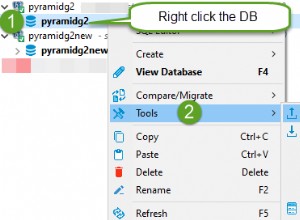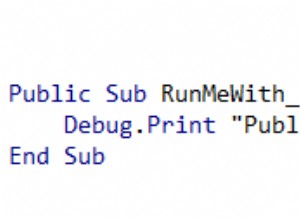Saya mengubah jawaban saya yang diberikan di pertanyaan pertama...
Akan lebih baik, jika tabel Anda akan menyimpan data relasi secara langsung di kolom yang diindeks. Sebelum Anda mengubah struktur tabel, Anda dapat mencoba ini:
Tabel dengan data uji
DECLARE @tbl TABLE ( AccountID VARCHAR(100), AccountName VARCHAR(100));
INSERT INTO @tbl VALUES
('11','Acc11')
,('12','Acc12')
,('13','Acc13')
,('11/11','Acc11/11')
,('11/12','Acc11/12')
,('11/111','Acc11/111')
,('11/11/001','Acc11/11/001')
,('11/11/002','Acc11/11/002')
,('12/111','Acc12/111')
,('12/112','Acc12/112');
Ini akan mendapatkan data yang dibutuhkan ke dalam tabel temp yang baru dibuat bernama #tempHierarchy
SELECT AccountID
,AccountName
,ROW_NUMBER() OVER(ORDER BY LEN(AccountID)-LEN(REPLACE(AccountID,'/','')),AccountID) AS ID
,Extended.HierarchyLevel
,STUFF(
(
SELECT '/' + A.B.value('.','varchar(10)')
FROM Extended.IDsXML.nodes('/x[position() <= sql:column("HierarchyLevel")]') AS A(B)
FOR XML PATH('')
),1,2,'') AS ParentPath
,Extended.IDsXML.value('/x[sql:column("HierarchyLevel")+1][1]','varchar(10)') AS ownID
,Extended.IDsXML.value('/x[sql:column("HierarchyLevel")][1]','varchar(10)') AS ancestorID
INTO #tempHierarchy
FROM @tbl
CROSS APPLY(SELECT LEN(AccountID)-LEN(REPLACE(AccountID,'/','')) + 1 AS HierarchyLevel
,CAST('<x></x><x>' + REPLACE(AccountID,'/','</x><x>') + '</x>' AS XML) AS IDsXML) AS Extended
;
Hasil antara
+-----------+--------------+----+----------------+------------+-------+------------+
| AccountID | AccountName | ID | HierarchyLevel | ParentPath | ownID | ancestorID |
+-----------+--------------+----+----------------+------------+-------+------------+
| 11 | Acc11 | 1 | 1 | | 11 | |
+-----------+--------------+----+----------------+------------+-------+------------+
| 12 | Acc12 | 2 | 1 | | 12 | |
+-----------+--------------+----+----------------+------------+-------+------------+
| 13 | Acc13 | 3 | 1 | | 13 | |
+-----------+--------------+----+----------------+------------+-------+------------+
| 11/11 | Acc11/11 | 4 | 2 | 11 | 11 | 11 |
+-----------+--------------+----+----------------+------------+-------+------------+
| 11/111 | Acc11/111 | 5 | 2 | 11 | 111 | 11 |
+-----------+--------------+----+----------------+------------+-------+------------+
| 11/12 | Acc11/12 | 6 | 2 | 11 | 12 | 11 |
+-----------+--------------+----+----------------+------------+-------+------------+
| 12/111 | Acc12/111 | 7 | 2 | 12 | 111 | 12 |
+-----------+--------------+----+----------------+------------+-------+------------+
| 12/112 | Acc12/112 | 8 | 2 | 12 | 112 | 12 |
+-----------+--------------+----+----------------+------------+-------+------------+
| 11/11/001 | Acc11/11/001 | 9 | 3 | 11/11 | 001 | 11 |
+-----------+--------------+----+----------------+------------+-------+------------+
| 11/11/002 | Acc11/11/002 | 10 | 3 | 11/11 | 002 | 11 |
+-----------+--------------+----+----------------+------------+-------+------------+
Dan sekarang pendekatan rekursif serupa terjadi seperti pada jawaban pertama saya. Tapi - karena sekarang menggunakan tabel nyata dan semua pemisahan string telah terjadi - seharusnya lebih cepat...
WITH RecursiveCTE AS
(
SELECT th.*
,CAST(NULL AS BIGINT) AS ParentID
,CASE WHEN EXISTS(SELECT 1 FROM #tempHierarchy AS x WHERE x.ParentPath=th.AccountID) THEN 1 ELSE 0 END AS HasChild
FROM #tempHierarchy AS th WHERE th.HierarchyLevel=1
UNION ALL
SELECT sa.AccountID
,sa.AccountName
,sa.ID
,sa.HierarchyLevel
,sa.ParentPath
,sa.ownID
,sa.ancestorID
,(SELECT x.ID FROM #tempHierarchy AS x WHERE x.AccountID=sa.ParentPath)
,CASE WHEN EXISTS(SELECT 1 FROM #tempHierarchy AS x WHERE x.ParentPath=sa.AccountID) THEN 1 ELSE 0 END AS HasChild
FROM RecursiveCTE AS r
INNER JOIN #tempHierarchy AS sa ON sa.HierarchyLevel=r.HierarchyLevel+1
AND r.AccountID=sa.ParentPath
)
SELECT r.AccountID
,r.AccountName
,r.ID
,r.ParentID
,r.HierarchyLevel
,r.HasChild
FROM RecursiveCTE AS r
ORDER BY HierarchyLevel,ParentID;
Dan akhirnya saya bersihkan
DROP TABLE #tempHierarchy;
Dan inilah hasil akhirnya
+-----------+--------------+----+----------+----------------+----------+
| AccountID | AccountName | ID | ParentID | HierarchyLevel | HasChild |
+-----------+--------------+----+----------+----------------+----------+
| 11 | Acc11 | 1 | NULL | 1 | 1 |
+-----------+--------------+----+----------+----------------+----------+
| 12 | Acc12 | 2 | NULL | 1 | 1 |
+-----------+--------------+----+----------+----------------+----------+
| 13 | Acc13 | 3 | NULL | 1 | 0 |
+-----------+--------------+----+----------+----------------+----------+
| 11/11 | Acc11/11 | 4 | 1 | 2 | 1 |
+-----------+--------------+----+----------+----------------+----------+
| 11/111 | Acc11/111 | 5 | 1 | 2 | 0 |
+-----------+--------------+----+----------+----------------+----------+
| 11/12 | Acc11/12 | 6 | 1 | 2 | 0 |
+-----------+--------------+----+----------+----------------+----------+
| 12/111 | Acc12/111 | 7 | 2 | 2 | 0 |
+-----------+--------------+----+----------+----------------+----------+
| 12/112 | Acc12/112 | 8 | 2 | 2 | 0 |
+-----------+--------------+----+----------+----------------+----------+
| 11/11/001 | Acc11/11/001 | 9 | 4 | 3 | 0 |
+-----------+--------------+----+----------+----------------+----------+
| 11/11/002 | Acc11/11/002 | 10 | 4 | 3 | 0 |
+-----------+--------------+----+----------+----------------+----------+




